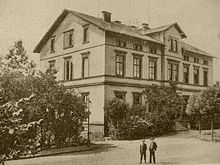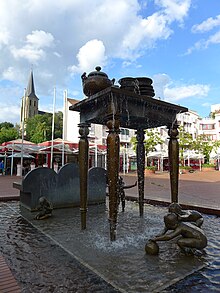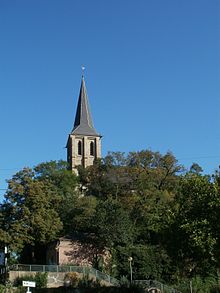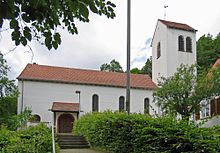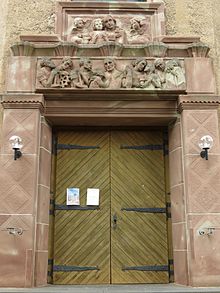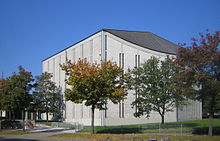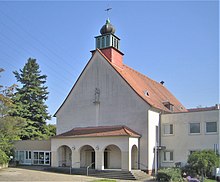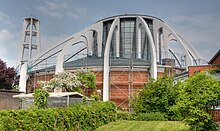Painting place
|
Painting place
City of Saarbrücken
|
||
|---|---|---|
| Coordinates: 49 ° 14 ′ 31 ″ N , 6 ° 58 ′ 26 ″ E | ||
| Residents : | 29,374 (Dec. 31, 2018) | |
| Incorporation : | 1874 | |
| Incorporated into: | Malstatt-Burbach | |
| Postcodes : | 66113, 66115 | |
| Area code : | 0681 | |
|
Location of Malstatt in Saarland |
||
|
Wilhelm Meyer Bridge in Malstatt
|
||
Malstatt is a district in the center of the Saarland capital of Saarbrücken . Around 29,500 people live there; Malstatt is thus the second most populous district after St. Johann .
Until 1874 Malstatt was an independent municipality. Subsequently, Malstatt belonged with the neighboring Burbach to the city of Malstatt-Burbach until it merged with Alt-Saarbrücken and St. Johann to form the city of Saarbrücken in 1909 .
geography
Malstatt is located in the north-west of the state capital Saarbrücken. The Saar is the southern limit . Malstatt belongs to the Mitte district and borders the districts of Burbach in the north and west, St. Johann in the south-east and Alt-Saarbrücken in the south. In the north it borders on the communities of Riegelsberg , Heusweiler and Qui greatest and in the east on the district of Dudweiler with the districts Herrensohr and Jägersfreude .
Surname
The place name comes from a court of the same name (Malstätte) . In the local dialect it is Mòlschd . (The ò stands for the long, open "o", which does not exist in Standard German . It roughly corresponds to a longer spoken "o" in "noch".)
history
Malstatt was first mentioned in a document in 960. The place was subject to changing rulers and belonged one after the other to the County of Nassau-Saarbrücken to the First French Republic , to the State of Prussia , to the League of Nations mandate "Saargebiet" , to the NS- Gau Westmark , to the independent Saar state and finally to the federal German Saarland .
The previously independent municipality of Malstatt was merged in 1874 with the neighboring town of Burbach to form the town of Malstatt-Burbach, and in 1908 this was combined with Alt-Saarbrücken and Sankt Johann an der Saar to form the independent capital and today's state capital of Saarbrücken, in which Malstatt belongs to the city district of Mitte .
Demographics
As of December 31, 2018, 29,374 people lived in Malstatt. Of these, 4,371 (14.9%) were younger than 15 years and 5764 (%) were older than 65 years. The German nationality had 21,802 inhabitants (74.2%). 7572 inhabitants (25.8%) were foreigners, of which 2405 (8.2%) were EU citizens and 5167 (17.6%) were non-EU foreigners. 57.5% of the households were one-person households; children lived in only 17.5% of households.
Due to the high unemployment, Malstatt and especially the southern districts 123 (Unteres Malstatt), 124 (Leipziger Strasse) and 125 (Jenneweg) are considered to be a social hotspot . In the three districts mentioned, between 44.5% and 48.1% of the population received unemployment benefit II or other transfer payments under the Unemployment Act on December 31, 2018 . In the entire district the number was 31.2%.
Nevertheless, there are the first signs of gentrification : the proximity to the city center, the cheap rents and the good transport connections through the Saarbahn make the city district attractive for young people and creative people, which is why rents are feared to rise.
Population development
|
|
politics
Party political tendencies
Analyzes by the city of Saarbrücken on the long-term voting behavior of its residents identified the Malstatter districts 123, 124 and 125 as strongholds of the party Die Linke , which also consistently achieved results above the overall city result in the rest of the district. The SPD also achieved above-average results over a longer period of time, but to a lesser extent. The results of the FDP and Bündnis 90 / Die Grünen were always well below the city-wide average.
Election results
| choice | voter turnout | SPD | CDU | The left | B'90 / Greens | FDP | other |
|---|---|---|---|---|---|---|---|
| City council election 2009 | 36.5% | 30.2% | 24.1% | 23.0% | 9.6% | 7.7% | 5.4% |
| State election 2009 | 55.0% | 23.5% | 25.5% | 31.7% | 7.4% | 8.0% | 3.9% |
| Bundestag election 2009 | 63.0% | 23.6% | 22.0% | 31.4% | 8.4% | 9.9% | 4.7% |
| State election 2012 | 48.7% | 30.1% | 26.0% | 24.2% | 6.3% | 1.1% | 12.3% |
| Bundestag election 2013 | 60.6% | 32.1% | 28.6% | 15.7% | 7.6% | 3.4% | 12.6% |
| City council election 2014 | 36.5% | 33.8% | 24.9% | 15.3% | 8.4% | 2.5% | 15.0% |
| State election 2017 | 57.3% | 28.9% | 30.2% | 20.7% | 5.3% | 3.0% | 11.9% |
| Bundestag election 2017 | 65.5% | 26.1% | 24.6% | 18.7% | 7.9% | 6.3% | 16.4% |
town hall
Today's technical-commercial vocational training center II of the city of Saarbrücken in Paul-Schmook-Straße (formerly Rathausstraße) was built in 1874 as the town hall of the formerly independent town of Malstatt-Burbach. After the unification of the cities, the town hall building was converted into a school between 1909 and 1910.
coat of arms
The former municipality of Malstatt was elevated to a town in 1874. It was not until October 4, 1897, together with Burbach, that the Prussian King Wilhelm II awarded her a coat of arms. It is divided: Above in a blue field studded with silver toe crosses, a soaring silver lion with a golden crown belonging to the Counts of Saarbrücken-Commercy . Hammer and mallet crossed in black in a silver field below, the handle ends covered with black, overturned open pliers (symbols of the Malstatt-Burbach industry). The coat of arms was crowned with a tinned city wall and three tinned towers. The city colors of Malstatt-Burbach were blue-white-black.
The coat of arms awarded to the new city of Saarbrücken by the Prussian King Wilhelm II on June 21, 1911 integrates the two arms of the coat of arms of the former city of Malstatt-Burbach.
Honorary citizen
The only honorary citizen of the former city of Malstatt-Burbach is Otto von Bismarck . In 1895 he was given honorary citizenship of Malstatt-Burbach as part of an initiative by other cities in the Prussian Rhine Province .
Infrastructure
traffic
Public transport
The connection from Malstatt to local public transport is generally considered good. An analysis commissioned by the city of Saarbrücken indicates that Malstatt has the highest proportion of season ticket holders in the city (39%). The district is served with six stops by Saarbahn Line 1 every 7.5 minutes. This connects the district with Sankt Johann , Von der Heydt and the district Halberg in Saarbrücken as well as the surrounding places Riegelsberg , Heusweiler , Lebach , Kleinblittersdorf in Saarland and Saargemünd in France. In addition, the Rodenhof district can be reached via the north entrance of Saarbrücken main station. In addition, Malstatt is connected to almost all parts of Saarbrücken via 11 bus routes operated by Saarbahn GmbH without having to change trains. Regional buses , which run from Saarbrücken to the northern suburbs, usually also go through Malstatt, but are of little practical importance for Malstatt, as they mostly run along Saarbahn line 1.
There are also two railway lines running through Malstatt: the Saarbrücken – Trier line and the less important Fischbachtalbahn (Saarbrücken – Illingen). Since the (now former) Schleifmühle station on the Fischbachtalbahn was shut down, Malstatt no longer has Deutsche Bahn stops . In the traffic development plan of the city of Saarbrücken, however, the construction of two stops on the Saarbrücken-Trier railway line is planned.
Private transport
The federal highways 51 and 268 run through Malstatt . In the north of Malstatt, the federal motorways 1 and 623 start just outside Malstatt, and the federal motorway 620 runs . Due to its location between five major streets, there is a lot of through traffic in Malstatt; In particular, residents near Lebacher Strasse (B268, leads to A1) and Camphauser Strasse are therefore complaining about the traffic load and in some cases are demanding truck driving bans.
education
In 1719, on the initiative of the Dudweiler pastor Barthels, the first schoolhouse was built in Malstatt and a schoolmaster from Burbach was hired. Before that, the Malstatter pastors had taught the children at school. Lessons only took place in the winter months. At the beginning of the 19th century, the Malstatter School was also attended by children from Burbach, Rußhütte, Rockershausen, Neudorf and Großwald. The first school in Burbach was founded in 1822. A Catholic school was established in Malstatt in 1834 and a Protestant school in Burbach in 1854. In the following year, 1855, a Catholic school was inaugurated in Burbach.
schools
There are currently the following schools in Malstatt:
Elementary schools
- Rodenhof primary school
- Rußhütte Primary School - Maria Montessori School
- All-day elementary school Rastpfuhl
- Rastpfuhl elementary school
- Wallenbaum primary school
- All-day primary school and Kirchberg primary school
Special schools
- Special school learning, school at Ludwigsberg
- Special school for intellectual development, Friedrich-Joachim-Stengel-School, Rastpfuhl
Vocational schools
- Technical-commercial vocational training center, TGBBZ II Saarbrücken, Malstatt branch
- St. Hildegard School Center, center for health professions
Community schools
- Ludwigspark Community School
Rastpfuhl campus of the University of Technology and Economics
The Saarland University of Technology and Economics maintains the Rastpfuhl campus on Lebacher Strasse . The Social Work and Childhood Education course is located there.
Medical supplies
In 1900, today's CaritasKlinikum Saarbrücken - St. Theresia was founded as the "Rastpfuhl Hospital". Today it is one of the oldest hospitals in the Saarland capital that still existed at the place where it was founded.
Parks and green spaces
Former park grounds of Schloss Ludwigsberg in Malstatt
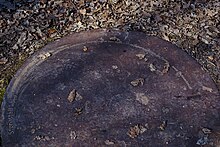
In 1763, a powder mill, then a madder and paint mill, a grinding mill, a loh mill and finally a grinding mill were set up on the site between the Malstatt districts of Rodenhof and Rußhütte . Between 1769 and 1791, Prince Ludwig von Nassau-Saarbrücken had a small pleasure palace built with an extensive English landscape garden on a plateau specially raised for this purpose . It was supposed to reflect the principle of a natural landscape , which should bring pleasure to the beholder's eyes through different and varied impressions in the sense of the ideal of a "walk-in landscape painting ".
Ludwigsberg Palace was integrated into the line of sight of the baroque residence city of Saarbrücken. The planning and design of the facility can be attributed to Friedrich Joachim Stengel's late creative period . It was only his son Balthasar Wilhelm Stengel who completed the garden artwork.
The prince's court gardener, Johann Friedrich Christian Köllner d. Ä. (1733–1809), initially designed a garden behind the small pleasure palace, characterized by winding paths, numerous figures and small architectures.
From 1788, under his son Heinrich Ludwig Köllner (1862–1724), the western extension of the gardens around the Schönthal was built. Between 1781 and 1791 the construction of a Diana grove was tackled, the star-shaped network of paths connecting a temple of the Roman goddess of hunting Diana and a forest theater . The garden's staffage buildings included: a Gothic building, a mosque with two small minarets, artificial ruins with a castle tower, a hermitage, a monkey barracks , a Chinese pagoda (named Adolphsfreude after the prince's son with Katharina Kest ), and a medieval-looking one Wall gate house, a replica of the grave of Jean-Jacques Rousseau in Ermenonville near Paris , a small hamlet with a chapel, which also served as a backdrop for open-air theater performances, a farm for the princess as well as a pile of wood and a haystack, which to the surprise of the visitors inside richly decorated rooms contained. In addition, there were jokingly intended grave monuments for people living at the time.
In the course of the French Revolution, the entire complex was destroyed on October 7, 1793 and not rebuilt. The remains of the wall were sold for demolition in 1804 and eight houses were built nearby using the material.
Ludwigspark
Ludwigsberg remained a popular local recreation area in the 19th century. The municipality of Malstatt-Burbach leased the site and, from 1895, had a public park with walking paths, playgrounds, a shooting range with shooting ranges and a large inn with a beer garden built here for 175,000 marks. The facility was opened in 1897. In 1908, the park was bought by the city of Malstatt-Burbach for 283,000 marks and was one of the local recreational attractions at that time.
Nowadays, the marked Ludwigspark walk leads through the historical places of Ludwigspark and Ludwigsberg. There are steel plates with information about its length.
Maltitz pavilion on Ludwigsberg
The single-storey baroque garden pavilion with a gabled two-lane central projectile and hipped roof was built around 1780 for Hofrat Karl Heinrich Franz von Maltitz . It is the last surviving example of the baroque garden houses from the second half of the 18th century, which wealthy Saarbrücken citizens and court officials had built in their gardens based on the model of princely park buildings. The former garden house was restored in the 1980s and has been used as a residential building (Saargemünder Straße) ever since.
Old graveyard
The old Malstatter cemetery on Jenneweg was Malstatt's cemetery from 1880 to 1912. It is dedicated and serves as a green area. Since then, the Burbach forest cemetery has served as Malstatt's burial place.
Bürgerpark
At the same time as the city of Saarbrücken was planning the Westspangen Bridge between Malstatt and St. Johann, ideas were developed in the mid-1980s for the creation of a park landscape for the fallow land on both sides of the old port area. Since the late 17th century, the coal mined in the Saarbrücken area had been weighed (Kohlwaage), stored and shipped from here. After the Second World War, the port close to the city center was abandoned and filled in as part of re-planning to rebuild the city of Saarbrücken. The French architect Georges-Henri Pingusson worked out the first post-war considerations for the reorganization of Saarbrücken . Pingusson had already planned a bridge, a green area, a congress hall and administration building for this area, but these were not implemented at the time due to financial problems in Saarbrücken's reconstruction phase. The congress hall only became a reality in 1967 based on a design by Dieter Oesterlen . Under the direction of landscape architect Peter Latz , the concept of a “community park” was developed in the 1980s with the cooperation of students, trainees and Saarbrücken citizens on an area of 9 hectares. This is where Malstatt's industrial past and present should meet in terms of design. The industrial site of the port, which had become fallow land, was to be transformed into a place of relaxation and to help raise awareness of the importance of the Saarland's industrial past. The Bürgerpark, which opened in 1989, was also intended to visibly document the economic and social structural change that had taken place in Saarland. The park was decorated with modern sculptures and enriched with water bodies.
Monuments and art in public spaces
Fountain sculpture "Mother Saar and her children"
In 1990/91 the artist Oswald Hiery , who comes from Ensdorf and lives in him , created the sculpture fountain "Mother Saar and her children" on the architecturally redesigned Malstatter Markt. The bronze fountain sculpture group should appear close to the people and remind of the historical population of Malstatt made up of craftsmen and industrial workers, i.e. the "little people". The entire group of sculptures is placed in a fountain basin. The nude woman sculpture, lying casually on a sofa, pours out a bottle of wine, "so that no one from Saarbrücken thinks that in 'Molschdt' things are like Fissels behind the sofa." An oversized table with dishes rises behind her. Bubbling well water gushes out of pots, tureens and stacks of plates and, according to the motto "Always on the little ones", flows down onto the five naked children romping around under the table. The entire installation should also evoke associations with the frequent floods of the Saar.
- Sculpture "Wandering Caspar David", sculptor: Michel Gérard, 1991, 12-part sculpture, cast iron, forged, height 4 m, diameter 12 m, Saarbrücken, Malstatt, Bürgerpark, Hafeninsel
The sculpture was set up in the open space near the Saarbrücken congress hall. The artist's goal was not to decorate the industrial desolation of the old port area, but to emphasize its characteristics: “I am trying to make sense of industrial sites that are still active or that have only recently been closed, which could give me a different insight into this industrial history. I am the witness of the downfall, the end of the industrial age, which presents its history as an existential experience, ”wrote Gérard about his work, which he prefixed with a diary entry by the painter Caspar David Friedrich :“ Bring darkly anticipated things from the depths of the night to the light of the Day. ”With the 12-part sculpture, which is supposed to be reminiscent of mining tools, Gérard created a walk-in picture in which he recalls the history of the place.
"Art garden" of the Union Foundation in Saarbrücken-Malstatt
The art garden shows sculptures by sculptors such as Seiji Kimoto , Sigrún Ólafsdóttir , Georg Zimmermann, Bertrand Ney, Paul Schneider , Leo Kornbrust , Jo Enzweiler and Werner Bauer .
Traugott-Roemer-Memorial, Malstatt-Rastpfuhl
The memorial is located at the Malstatter Rastpfuhl on Lebacher Straße. It is reminiscent of Traugott Roemer from the Rhenish Field Artillery Regiment No. 8 from Koblenz. Traugott Römer was born on May 5, 1846 in Stolberg and was torn to pieces by a grenade at the approximate location of his memorial on August 2, 1870 at the age of 24 during the fighting of the Franco-Prussian War . The erection of the memorial with burial place was made possible in 1884 by donations.
Cultural and sports facilities
Ludwigsparkstadion
The sports stadium was opened on August 2nd, 1953 in the Malstatter Ludwigspark and is currently the largest soccer stadium in Saarland with a capacity of around 35,000 spectators (8,303 of which are seats) . In the industrial era, the sports clubs were also very successful: In 1927, Sportfreunde 05 Saarbrücken , which was trained by Jupp Derwall in the 1960s , moved up to the first class. Even the 1. FC Saarbrücken , which was founded in 1903 as a football department of the TV 1876 Malstatt, in the tradition of the workers' football clubs .
Saarlandhalle
The Saarlandhalle was built in 1967 as a multifunctional hall within the Malstatter Ludwigspark and offers space for events for up to 5,500 people.
religion
- middle Ages
Malstatt has been part of the Trier diocese since the Middle Ages and was owned by the St. Peter's nunnery in Metz. Since the 16th century, the counts of Saarbrücken were also involved in the appointment of pastors. A religious brotherhood in Malstatt promoted church purposes.
- reformation
With the great church visit of 1575, the Lutheran denomination was forcibly introduced in Malstatt. The measures began on January 1, 1575 by order of Count Philip III. from Nassau-Saarbrücken in the entire domain. The Saarbrücken court preacher Gebhard Beilstein from Wetzlar was commissioned with the implementation . Catholic priests were removed from office or committed to the new doctrine, church property confiscated, schools set up and church patronage taken over, the celebration of traditional “pagan customs” such as the St. John's fire and dancing on Sundays was forbidden as a punishment. Count Philipp issued an extensive church ordinance for this . The commitment to the Reformation exacerbated the dispute with the Duchy of Lorraine, which remained Catholic.
- Destruction and reconstruction
With the destruction of Malstatt in the Thirty Years War in 1635 by Croatian troops from Emperor Ferdinand II and in 1641 when Lorraine troops set the Malstatt church on fire, Malstatt practically ceased to exist as a parish. The surviving residents received pastoral care from Gersweiler, St. Johann and Dudweiler over the next few decades. It was not until 1738 that Malstatt became independent again as a parish. After the parish church was destroyed in the French Revolution, the church building could only be restored in 1815 through financial contributions from French war compensation under the direction of Pastor Johann Friedrich Köllner , who was also mayor of Saarbrücken and St. Johann from 1816 to 1823.
- New church buildings in Prussian times
In 1846 Gersweiler was raised to an independent parish. A new Evangelical Church was built in Malstatt itself in 1868 . On the Burbacher Weyersberg, a new Protestant church was built from 1891 to 1898 (today the Matthäuskirche ). The St. Eligius Church was built in Burbach in the years 1869–1873 for the group of Catholic residents, which had grown significantly in number. As a result of the Kulturkampf , this parish remained vacant until 1884 and was looked after from St. Johann . In Malstatt, a Catholic emergency church St. Josef was built in 1888/1889 until a new stone building was completed. The large neo-Gothic building of St. Joseph's Church was inaugurated in 1910. After the number of Catholics in 1905 doubled that of Evangelicals (Catholics: 25,424; Evangelicals: 12,969), the construction of the Burbach Herz-Jesu-Kirche began in 1912 and was completed in 1914. New church buildings in the 20th century
- Catholic Church of St. Marien, Malstatt-Rußhütte, (1926–1927)
- Catholic Church of St. Anthony of Padua (former Franciscan monastery church), Rastpfuhl, (1929)
- Evangelical Church Malstatt-Rußhütte, (1936–1937)
- Catholic Church of St. Albertus Magnus on the Rodenhof (1938/39; destroyed in the war in 1944, completely rebuilt 1952–1954)
- Catholic Church of St. Paul, Malstatt-Rastpfuhl, (1959–1961)
- Evangelical Community Center Knappenroth, Malstatt-Rastpfuhl, (1995)
- Catholic Church of St. Albertus Magnus on the Rodenhof, (1952–1954)
There are currently the following churches in Malstatt:
In 1732 a new rectangular hall building was built on the ruins of the old Malstatter village church that had been destroyed in the Thirty Years War . The baroque hall building was demolished in 1868 due to dilapidation and a historicist new building was erected in the years 1868–1870 by the Saarbrücken building inspector Friedrich Seyffarth using a plan drawn up by the Berlin building councilor Friedrich August Stüler . The local construction management was the responsibility of Hugo Dihm from Saarbrücken. After destruction in the Second World War, a major change in reconstruction took place in 1952–1954. The church was expanded to include a transept and another floor. The former neo-Gothic window openings were also all changed. The architect of the reconstruction was Rudolf Krüger from Saarbrücken. In the years 1996-1998 the masonry and tower of the church had to be restored. The church windows are by György Lehoczky (3 windows in the chancel in 1953, 2 small windows in the entrance area under the organ loft in 1954). The altar cross was made by sculptor houses. The textile artist Kathrin Niemeyer created the paraments on the altar and the pulpit. The ribbed vault in the entrance area, which was not destroyed in the war, has been preserved from the neo-Gothic era. The church is assigned to the Evangelical Church in the Rhineland .
- Malstatt-Russhütte Evangelical Church
The parish church in the Malstatt district of Rußhütte was built between 1936–1937 according to plans by the Saarbrücken architect Rudolf Krüger. After war destruction, an emergency church donated by Swiss churches was inaugurated in Rheinstrasse in 1947. The reconstruction of the Rußhütter Church began in 1949 by the Saarbrücken architect Rudolf Krüger. The glass paintings were made by the artists György Lehoczky (Saarbrücken) and Oberberger. The painting on the north wall was created as a copy of the resurrection group on the Isenheim Altarpiece .
- Evangelical Community Center Knappenroth, Malstatt-Rastpfuhl
As early as the 1950s, the Protestant church had plans to build a Protestant community center on the site of a former brickworks in Knappenroth, which should include a church with a rectory, a kindergarten and a nurses' station with a sexton. Of these, the kindergarten (with a provisional church service and classroom in the basement) and the rectory in Hochwaldstrasse were built by 1960. In 1995 the kindergarten was expanded to include the current Protestant community center. The church service room is located in a rotunda and offers space for around 60 people.
- Catholic Church St. Marien , Malstatt-Rußhütte
Until the establishment of the parish of St. Josef in Malstatt in 1887, the Rußhütte, which was built in 1721 by the master glassblower August Guthmann, who had built a glassworks here with the permission of Count Karl Karl Ludwig von Nassau-Saarbrücken and had eight families settled here, was like the remaining parts of the present-day city of Saarbrücken were looked after by the parish of St. Johann. The rather long walking distance (3/4-hour walk) between the Rußhütte and St. Johann was problematic for the exercise of pastoral care. At the beginning of the 19th century, Russhütte and Malstatt had a total of 75 households with 450 inhabitants. By 1880, the population of the soot hut had increased to 778. From 1887 Malstatt and Rußhütte were separated from St. Johann and raised to the status of an independent parish of St. Josef. From then on, the Catholics of the Russhütte were looked after by chaplains from St. Josef. In 1893 a church building association was founded in Rußhütte under the initiative of the pastor of St. Josef, Matthias Metzdorf. The sudden death of Pastor Metzdorf and the outbreak of the First World War put the planning to an early end. Only after the First World War could an emergency church be put into service in 1919. Finally, in 1922, the independent parish of St. Marien in Rußhütte was established by the episcopal vicariate in Trier. The Catholic Church of St. Mary (Patronage of the Assumption ) was built in the years 1926–1927 by the Mainz architects Ludwig Becker and Anton Falkowski in an abstract neo-baroque style. It was consecrated on October 10, 1929 by the Trier auxiliary bishop Antonius Mönch. In 1938 part of the parish of St. Mary was re-parish to the mother parish of St. Josef. In an air raid in 1945, the Rußhütter Church was destroyed and rebuilt in 1947–1949. Today the parish of St. Marien exists in a pastoral care unit with St. Albert.
Since the Josefsbrücke, which connected the upper and lower Malstatt, was destroyed by the Second World War, a wooden barrack church was built for the parishioners of St. Josef in the upper Malstatt on Pariser Platz opposite today's St. Paulus Church. In 1959, on the initiative of Pastor Johannes Pütz (parish of St. Josef), the new parish of St. Paulus was formed from parts of the parish of St. Joseph, St. Antonius and Herz Jesu. The church should also serve as a pastoral care center for the Italian guest workers and their families. The modern church building was built between 1959 and 1961 according to the plans of the Trier architect Fritz Thoma. The large hall church, consciously based on the formal scheme of industrial architecture, was intended to remind of the working world of the people in the residential area. The unusually spacious church building was one of the first in Europe with a sagging prestressed concrete roof. As the building structure became very difficult over the years, the interior of the church was completely changed between 1978 and 1982 under Pastor Beils according to plans by the architect Van Stipelen. The originally light interior was bricked in to create a more inviting impression. The sagging flat roof was replaced by a tent roof. Due to other structural defects, the bell tower had to be demolished in 2006. The bells of St. Paulus were sold and ring today in Remagen. Instead of the bell tower, four church flags now draw attention to the church.
- Catholic Church of St. Anthony of Padua (former Franciscan monastery church)
In 1920 the Franciscan order bought the house Rastpfuhl 12 at the end of the upper Malstatt at that time. In the following years today's church of St. Antonius of Padua and the monastery buildings were built. The inauguration took place in 1929. The Bishop of Trier, Franz Rudolf Bornewasser, set up the pastoral care district of St. Antonius without its own asset management, dependent on the mother parish of St. Josef in Malstatt. He entrusted the pastoral care of the young community on the Rastpfuhl to a member of the monastery . After war damage and changes in reconstruction, a parish home with a kindergarten was built in Lebacher Strasse in 1953. In 1954, St. Antonius was officially raised from a vicarie to a parish. The Franciscan monks sold the monastery church and the monastery to the Trier diocese and the parish in 1965 and set up a Franciscan educational facility in the nearby Rhönweg. The parish opens a kindergarten and a parish office. The parish home with kindergarten on Lebacher Strasse was rented to Caritas in 1981 and sold in 1997. As a result, extensive renovation work was initiated on the former monastery building and the Catholic University of Applied Sciences for Social Work began its activities here. The technical college was closed in 2008. The course was relocated to the University of Applied Sciences (HTW) Saarbrücken . In 1999 the Franciscan order gave up its educational establishment in the Rhönweg and ended its pastoral work in Saarbrücken. In 2002 the parish built a new meeting place for the parish on the Malstätter Rastpfuhl with the reconstruction of the parish office and parish rooms.
- Catholic Church St. Albertus Magnus , Rodenhof
Personalities
- Johann Friedrich Köllner (1764–1853), Protestant pastor (literally "de Paff vun Molschd"), educator, local historian, local politician in Malstatt and from 1816 to 1823 mayor of (old) Saarbrücken
- Wilhelm Meyer (1835–1900), Mayor of Malstatt-Burbach (1866–1900)
- Georg Heckel (1839–1899), merchant and benefactor
- Carl von Fidler (1856–1927), Prussian administrative lawyer, police director of Malstatt-Burbach
- Paul Schmook (1860–1921), lawyer, mayor of Malstatt-Burbach (1900–1909), co-initiator of the city association of Malstatt-Burbach, St. Johann and Saarbrücken
- Hubert Nold (1861–1935), Protestant pastor and superintendent in Malstatt-Burbach, builder of the Matthäuskirche (Saarbrücken-Burbach) on the Weyersberg
- Johann Adam Rüppel (1864–1930), builder of the Malstatter Church of St. Josef.
- Franz-Josef Bungarten (1876–1965), Catholic pastor in Malstatt ( St. Josef (Saarbrücken) ), Nazi opponent and Saarland politician
- Jakob Johannes (1877–1919), victim of the League of Nations
- Philipp Bleek (1878–1948), Protestant clergyman and resistance fighter against National Socialism, pastor in Malstatt
- Franz Hofer (1882–1945), film director
- Anton Wendling (1891–1965), painter and creator of the church windows in the Malstatter Church of St. Josef
- Heinrich Barth (1895–1949), crane operator, persecuted by the Nazi system, politician (SPS), member of the Saarland state parliament and honorary mayor of Saarbrücken
- Fritz Zolnhofer (1896–1965), painter, resident at the Malstatter Rastpfuhl
- Gustav Simon (1900–1945), NSDAP Gauleiter of the Gaus Moselland, at the same time head of civil administration (CdZ) in Luxembourg from 1940 to 1944
- Mathias Erang (1902–1978), artistic gymnast
- Edgar Jené (1904–1984), German-French painter, graphic artist and surrealist
- Peter Schlicker (1909–1945), Catholic chaplain, persecuted by the Nazi regime
- Käthe Limbach , b. Westenburger (1915–2003), resistance fighter against National Socialism and member of the KPD
- Ferdi Hartung (1931–2014), sports photographer
literature
- Christof Trepesch: The English landscape garden on Ludwigsberg in Saarbrücken on the basis of unknown drawings and designs . In: Die Gartenkunst 8 (1/1996), pp. 1–10.
- Klaus Bernarding : First Saarbrücken district author (1981/82 )
Web links
- http://www.saarlandbilder.net/orte/saarbruecken/malstatt/index.html
- Literature on Malstatt in the Saarland Bibliography
- http://www.unser-malstatt-online.de/
Individual evidence
- ↑ a b c d e Office for Development Planning, Statistics and Elections. State capital Saarbrücken, accessed on April 16, 2019 .
- ^ Meyers Großes Konversations-Lexikon, Volume 13. Leipzig 1908, p. 105: Mahlstatt. On-line
- ↑ Evangelisches Pfarramt Malstatt (Ed.): Thousand Years Church in Malstatt 960–1960, Saarbrücken 1960, p. 3.
- ^ Albert Ruppersberg: History of the former county of Saarbrücken, history of the cities of Saarbrücken and St. Johann 1815-1909, the city of Malstatt-Burbach and the united city of Saarbrücken until 1914, Volume III, Part 2, 2nd edition from 1914, Saarbrücken 1914, p. 192.
- ^ Albert Ruppersberg: History of the former county of Saarbrücken, history of the cities of Saarbrücken and St. Johann 1815-1909, the city of Malstatt-Burbach and the united city of Saarbrücken until 1914, Volume III, Part 2, 2nd edition from 1914, Saarbrücken 1914, pp. 179-181.
- ^ Albert Ruppersberg: History of the former county of Saarbrücken, history of the cities of Saarbrücken and St. Johann 1815-1909, the city of Malstatt-Burbach and the united city of Saarbrücken until 1914, Volume III, Part 2, 2nd edition from 1914, Saarbrücken 1914, pp. 179-181.
- ^ Office for self-organization and participation . buergergesellschaft.de. Retrieved April 5, 2016.
- ↑ http://www.saarbruecken.de/media/download-53355186b2240
- ↑ http://www.saarbruecken.de/media/download-532aef57eccbc
- ↑ http://www.saarbruecken.de/media/download-5915a373d595a
- ↑ http://www.saarbruecken.de/media/download-532aef57c7b0a
- ↑ http://www.saarbruecken.de/media/download-5915a373d595a
- ↑ http://www.saarbruecken.de/media/download-5c7942a3f1415
- ↑ http://www.saarbruecken.de/media/download-58d90f9daf46e
- ↑ http://www.saarbruecken.de/media/download-59c8d2b3cb853
- ↑ Kurt Hoppstädter: The coat of arms of the Saarland, part 1, ed. v. Historical Association for Saarland e. V. in cooperation with the archive of the Saarland government, Saarbrücken, 1953, pp. 77–79.
- ^ Albert Ruppersberg: History of the former county of Saarbrücken, history of the cities of Saarbrücken and St. Johann 1815-1909, the city of Malstatt-Burbach and the united city of Saarbrücken until 1914, Volume III, Part 2, 2nd edition from 1914, Saarbrücken 1914, pp. 187-188.
- ^ Rolf Wittenbrock: Die Drei Saarstädte (1860-1908): Local self-government and political culture, in: Rolf Wittenbrock: Geschichte der Stadt Saarbrücken, Vol. 2, From the time of stormy growth to the present, Saarbrücken 1999, p. 11– 38, here p. 36.
- ↑ http://vep.saarbruecken.de/media/download-5566e5bd5cab1 p. 42
- ↑ a b Saarbahn timetable
- ^ VEP Saarbrücken, field of action C: Public transport
- ^ Albert Ruppersberg: History of the former county of Saarbrücken, history of the cities of Saarbrücken and St. Johann 1815-1909, the city of Malstatt-Burbach and the united city of Saarbrücken until 1914, Volume III, Part 2, 2nd edition from 1914, Saarbrücken 1914, pp. 211-213.
- ↑ Schools . regionalverband-saarbruecken.de. Archived from the original on September 6, 2014. Retrieved April 5, 2016.
- ↑ https://www.tgbbz2.de/
- ↑ cts-Schulzentrum St. Hildegard - Center for health professions . cts-schulzentrum.de. Retrieved April 5, 2016.
- ↑ http://www.saarbruecken.de/de/bildung/hochschulen/hochschule_fuer_technik_und_wirtschaft_des_saarlandes
- ^ Health for Generations - The History of the Caritasklinik St. Theresia 1900–2010, p. 35.
- ↑ | City of Saarbrücken: Ludwigspark - walk through the Ludwigspark on the trail of the old park
- ^ A b Albert Ruppersberg: History of the former county of Saarbrücken, history of the cities of Saarbrücken and St. Johann 1815–1909, the city of Malstatt-Burbach and the unified city of Saarbrücken up to 1914, Volume III, Part 2, 2nd edition from 1914 , Saarbrücken 1914, pp. 197-198.
- ↑ State capital Saarbrücken (Ed.): Ludwigspark . Walk through Ludwigspark on the trail of the old park. 1st edition. Saarbrücken ( online [PDF; 1.8 MB ]).
- ↑ Kurt Hoppstädter: The Saarbrücker Hofadel in the 18th century, in: Wilhelm Heinrich von Nassau-Saarbrücken, ed. by Hans-Walter Herrmann and Hanns Klein, Saarbrücken 1968, pp. 116–118.
- ↑ Dieter Heinz: Ludwigsberg, Schönthal, Dianenhain, in: Saarheimat 5, 1961, pp. 7-14.
- ^ Margit Vonhof: Balthasar Wilhelm Stengel, the chief building director of Prince Ludwig of Nassau-Saarbrücken, in: Florilegium artis, contributions to art history and monument preservation, Festschrift for Wolfgang Götz on the occasion of his 60th birthday on February 12, 1983, Saarbrücken 1984, p. 155– 160.
- ↑ Alheidis von Rohr: 26 architectural designs by Balthasar Wilhelm Stengel in the art library of the State Museums of Prussian Cultural Heritage in Berlin, in: Saarbrücker Hefte 30, 1969, pp. 55–60.
- ↑ Oranna Dimmig: Two architectural designs by Balthasar Wilhelm Stengels for the gardens on Ludwigsberg, in: Gartenkunst in Saarbrücken, catalog for the exhibition of the same name in the Old Collection of the Saarland Museum from June 20, 1999 to August 29, 1999, Christof Trepesch [ed.] , Worms 1999, pp. 129-134.
- ↑ Hans-Christoph Dittscheid: A key to the Dianenhain, in: Gartenkunst in Saarbrücken, Gartenkunst in Saarbrücken, catalog for the exhibition of the same name in the Old Collection of the Saarland Museum from June 20, 1999 to August 29, 1999, Christof Trepesch [ed.] , Worms 1999, p. 135 ff.
- ^ Karl Lohmeyer: Southwest German Gardens of the Baroque and Romanticism, Saarbrücken 1937.
- ↑ Paul Minoti: Der Ludwigsberg, Fürstliche Gartenkunst in Saarbrücken (1769–1793), in: Echolot, Historical Contributions of the State Archives Saarbrücken Vol. 8, Saarbrücken 2009, p. 281.
- ^ Karl August Schleiden: Illustrated History of the City of Saarbrücken, Dillingen / Saar 2009, pp. 128-131.
- ^ Ludwigsberg Palace and Maltitz Pavilion . saarbruecken.de. Retrieved April 5, 2016.
- ↑ Köllner Heinrich Ludwig . saarland-biografien.de. Archived from the original on April 19, 2016. Retrieved April 5, 2016.
- ^ Köllner Johann Friedrich Christian the Elder Ä. . saarland-biografien.de. Archived from the original on April 19, 2016. Retrieved April 5, 2016.
- ^ Michel Gérard, Sculptures 1976–1988, Mannheim 1988.
- ↑ Claudia Maas: The Bürgerpark in Saarbrücken and the sculpture group Wandering a Caspar David by Michel Gérard, in: Jo Enzweiler (Ed.): Art in Public Space Saarland, Volume 1, Saarbrücken District Center, Saarbrücken 1997, pp. 102-108.
- ↑ a b Jo Enzweiler and Erik Schrader (eds.): Kunstort, art in public space in Saarbrücken-St. Johann, Saarbrücken 2010.
- ↑ Oswald Hiery, sculptor . oswald-hiery.homepage.t-online.de. Retrieved April 5, 2016.
- ^ Saarbrücker Zeitung from 27./28. July 1991, article "Mother Saar gives out".
- ↑ Letter Oswald Hierys to the City Planning Office Saarbrücken 1990th
- ↑ Gérard, Michel . Art Lexicon Saar. Retrieved April 5, 2016.
- ^ Michel Gérard: Sculptures 1976–1988, Mannheim 1988.
- ↑ Jo Enzweiler (Ed.): Art in Public Space Saarland, Volume 1, Saarbrücken, Mitte district, Saarbrücken 1997, in it: Claudia Maas: The Bürgerpark in Saarbrücken and the sculpture group Wandering a Caspar David by Michel Gérard, pp. 102-108 .
- ^ Art garden, Union Foundation Saarbrücken, Insights, Saarbrücken 2010.
- ↑ Uwe Beyer: Das Grabmal des Traugott Roemer, in: Der Rastpfuhl, history of a settlement area and its inhabitants, ed. v. German Settlers Association Saarland Association V., Siedlergemeinschaft Saarbrücken Rastpfuhl, Volkshochschule Stadtverband Saarbrücken, Saarbrücken 1999, pp. 12–13.
- ^ Albert Ruppersberg: History of the former county of Saarbrücken, history of the cities of Saarbrücken and St. Johann 1815-1909, the city of Malstatt-Burbach and the united city of Saarbrücken until 1914, Volume III, Part 2, 2nd edition from 1914, Saarbrücken 1914, pp. 199-210.
- ↑ a b Joachim Conrad and Erwin Klampfer: The churches of the parish of Saarbrücken, a short historical outline, commemorative publication for the 90th birthday of Pastor i. R. Eduard Heinz, Saarbrücken 1983.
- ^ György Lehoczky 1901–1979, Saarbrücken 2010.
- ↑ Kristine Marschall: Sacred buildings of classicism and historicism in Saarland, Institute for Regional Studies in Saarland, Saarbrücken 2002.
- ^ Institute for Contemporary Art in Saarland, archive, holdings Saarbrücken, Protestant parish church Malstatt (Dossier K 893)
- ^ György Lehoczky 1901–1979, Saarbrücken 2010.
- ^ Institute for Contemporary Art in Saarland, archive, holdings Saarbrücken, Protestant parish church Rußhütte (Dossier K 398)
- ^ Evangelical Community Center Knappenroth . evangelischmalstatt.de. Retrieved April 5, 2016.
- ^ Metzdorf Matthias . saarland-biografien.de. Archived from the original on September 3, 2014. Retrieved April 5, 2016.
- ↑ Welcome to the parish of St. Marien Russhütte in Saarbrücken . st-marien-russhuette.de. Archived from the original on April 12, 2016. Retrieved April 5, 2016.
- ↑ St. Paul . stjosef-saarbruecken.de. Retrieved April 5, 2016.
- ↑ St. Antonius, Catholic parish Saarbrücken-Rastpfuhl, 1937–1987, Rhenania Franciscana, family sheet of the Cologne Franciscan Province of the Three Kings, Supplement 6, ed. v. Otho Gimmnich (OFM) and Bernward Kliewer (OFM), Saarbrücken 1987.
- ↑ St. Anthony's Church . stjosef-saarbruecken.de. Retrieved April 5, 2016.
- ^ Fidler Carl Wilhelm Ferdinand von . saarland-biografien.de. Archived from the original on April 18, 2016. Retrieved April 5, 2016.
- ↑ Bungarten Franz-Josef . saarland-biografien.de. Archived from the original on April 17, 2016. Retrieved April 5, 2016.
- ↑ Bleek Philipp . saarland-biografien.de. Archived from the original on April 16, 2016. Retrieved April 5, 2016.
- ^ Andrea Dittgen: Franz Hofer, Saarbrücken 1999.
- ↑ Hofer Franz . saarland-biografien.de. Archived from the original on April 19, 2016. Retrieved April 5, 2016.
- ↑ Wendling Anton . saarland-biografien.de. Archived from the original on April 19, 2016. Retrieved April 5, 2016.
- ↑ Walter Schmeer: Fritz Zolnhofer, in: Saarheimat 9th year (1965), pp. 145–149.
- ↑ Dieter Wolfanger, Josef Bürckel and Gustav Simon, in: Zwischen Saar und Mosel, Saarbrücken 1995, pp. 397-409.
- ↑ Simon Gustav Johannes . saarland-biografien.de. Archived from the original on April 18, 2016. Retrieved April 5, 2016.
- ↑ Helmut Moll: Zeugen für Christus, Das deutsche Martyrologium des 20. Jahrhundert, Vol. 1, Paderborn 2006, pp. 574-577.
- ↑ Schlicker Peter . saarland-biografien.de. Archived from the original on April 19, 2016. Retrieved April 5, 2016.
- ^ Klaus Bernarding E. Mail born in 1935 in Schmelz: Klaus Bernarding. Retrieved July 27, 2020 .



